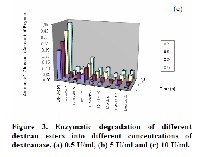Synthesis and characterization of dextran esters as coating or matrix systems for oral delivery of drugs targeted to the colon
Keywords:
Colon-Specific Drug Delivery, Polysaccharides, Dextran, Dextranase, Dextran esters, Enzymatic Degradation, Eudragit® RS 30D, Sidby-side diffusion cellAbstract
Different dextran esters with various degrees of substitution (1, 2 and 3) were synthesized by esterification reaction, with three acid anhydrides: acetic anhydride, propionic anhydride, and butyric anhydride, separately. These modified polysaccharides were characterized by FT-IR, 1H NMR and 13C NMR spectroscopies. Enzymatic degradation of biopolymers by dextranase was also studied. The polymers showing the best degradation profiles were chosen to design blended free films in combination with a polymethacrylate (Eudragit® RS 30D) as a sustained release system for targeting to the colon. These free films were evaluated by permeability of theophylline used as tracer in different in vitro media of the gastro intestinal tract, in presence or in absence of dextranase. From these studies, it was concluded that dextran esters having the lower degree of substitution and constituted of short carbohydrate chains showed the best and significant enzymatic degradation and could be used as a promising carrier for specific colon drug delivery system.
References
Lee V.H.L., Yang J.J. Oral Drug Delivery in Drug
Delivery and Targeting, 2001; 145-183. A. M.
Hillery, A. W. Lloyd, and J. Swarbrick (eds.).
Taylor and Francis, London.
Rosen H., Abribat, T. The rise and rise of drug
delivery. Nat Rev Drug Discov 2005; 4: 1-5.
Ibekwe V.C., Kendall R.A., Basit, A.W. Drug
Delivery to the Colon. Pharma Ventures Ltd 2004;
-30.
Basit A., Bloor J. Perspectives on Colonic Drug
Delivery. Business Briefing: Pharmat Ech 2003;
-190.
Patel M., Shah T., Amin A. Therapeutic
opportunities in colon specific drug- delivery
systems. Crit Rev Ther Drug Carrier Syst 2007; 24:
-202.
Sinha V.R., Kumria B. Polysaccharides in colonspecific drug delivery. Int J Pharm 2001; 224: 19–
Vandamme T.F., Lenoury A., Charrueau C.,
Chaumeil J.C. The use of polysaccharides to target
drugs to the colon. Carbohyd Polym 2002; 48: 219-
Sinha V.R., Kumria R. Microbially triggered drug
delivery to the colon. Eur J Pharm Sci 2003; 18: 3–
Simonsen L., Hovgaard L., Mortensen P.B.,
Brondsted H. Dextran hydrogels for colon-specific
drug delivery. V. Degradation in human intestinal
incubation models. Eur J Pharm Sci 1995; 3: 329-
Hirsch S., Binder V., Schehlmann V., Kolter K.,
Bauer K.H. Lauroyldextran and crosslinked
galactomannan as coating materials for site-specific
drug delivery to the colon. Eur J Pharm Biopharm
; 47: 61–71.
Jeong Y.I., Choi K.C., Song C.E. Doxorubicin
Release from Core-Shell Type Nanoparticles of
Poly(DL-lactide-co-glycolide)-Grafted Dextran.
Arch Pharm Res 2006; 29: 712-719.
Sriamornsak S., Nunthanid J., Wanchana S.,
Luangtana-Ana M. Composite film-coated tablets
intended for colon-specific delivery of 5-
aminosalicylic acid using deesterified pectin.
Pharm Dev Technol 2003; 8: 311-318.
Won C.Y., Chu C.C. Dextran-estrone conjugate:
synthesis and in vitro release study. Carbohyd
Polym 1998; 36: 327–334.
Sun G., Chu C.C. Synthesis, characterization of
biodegradable dextran–allyl isocyanate–
ethylamine/polyethylene glycol–diacrylate
hydrogels and their in vitro release of albumin.
Carbohyd Polym 2006; 65: 273–287.
Teramoto N., Shibata M. Synthesis and properties
of pullulan acetate. Thermal properties,
biodegradability, and a semi-clear gel formation in
organic solvents. Carbohyd Polym 2006; 63: 476–
Franssen O., Vos O.P., Hennink W.E. Delayed
release of a model protein from enzymaticallydegrading dextran hydrogels. J Control Rel 1997;
: 237-245.
Franssen O., Stenekes R., Hennink W. Controlled
release of a model protein from enzymatically
degrading dextran microspheres. J Control Rel
; 59: 219–228.
Akhgari A., Farahmand F., Afrasiabi Garekani H.,
Sadeghi F., Vandamme T.F. Permeability and
swelling studies on free films containing inulin in
combination with different polymethacrylates
aimed for colonic drug delivery. Eur J Pharm Sci
; 28: 307–314.
Lin W.J., Lu C.H. Characterization and permeation
of microporous poly(ε-caprolactone) films. J
Membrane Sci 2002; 198: 109–118.
Fang J.M., Sun R.C., Tomkinson J., Fowler P.
Acetylation of wheat straw hemicellulose B in a
new non-aqueous swelling system. Carbohyd
Polym 2000; 41: 379–387.
Ferreira L., Gil M.H., Dordick J.S. Enzymatic
synthesis of dextran-containing hydrogels.
Biomaterials 2002; 23: 3957–3967.
Liebert T., Hornig S., Hesse S., Heinze T.
Nanoparticles on the Basis of Highly
Functionalized Dextrans. J Am Chem Soc 2005;
: 10484-10485.
Hornig S., Heinze T. Nanoscale structures of
dextran esters. Carbohyd Polym 2007; 68: 280–
Sun X.F., Sun R.C., Zhao L., Sun J.X. Acetylation
of sugarcane bagasse hemicelluloses under mild
reaction conditions by using NBS as a catalyst. J
Appl Polym Sci 2004; 92: 53–61.
Wang L.Q., Tu K., Li Y., Zhang J., Jiang L., Zhang
Z. Synthesis and characterization of temperature
responsive graft copolymers of dextran with
poly(N-isopropylacrylamide). React Funct Polym
; 53: 19–27.
Chiu H.C., Wu A.T., Lin Y.F. Synthesis and
characterization of acrylic acid-containing dextran
hydrogels. Polymer 2001; 42: 1471–1479.
Mehvar R. Dextrans for targeted and sustained
delivery of therapeutic and imaging agents. J
Control Rel 2000; 69: 1–25.
Park K., Shalaby W.S.W., Park H. Enzymecatalyzed degradation in Biodegradable Hydrogels
for Drug Delivery, 1993; 153-187. Park K.,
Shalaby W.S.W., Park H. (eds.). Technomic
Publishing Company, Lancaster U.S.A.
Bauer K.H., Kesselhut J.F. Novel pharmaceutical
excipients for colon targeting. S.T.P. Pharma
Sciences 1995; 5: 54-59.






